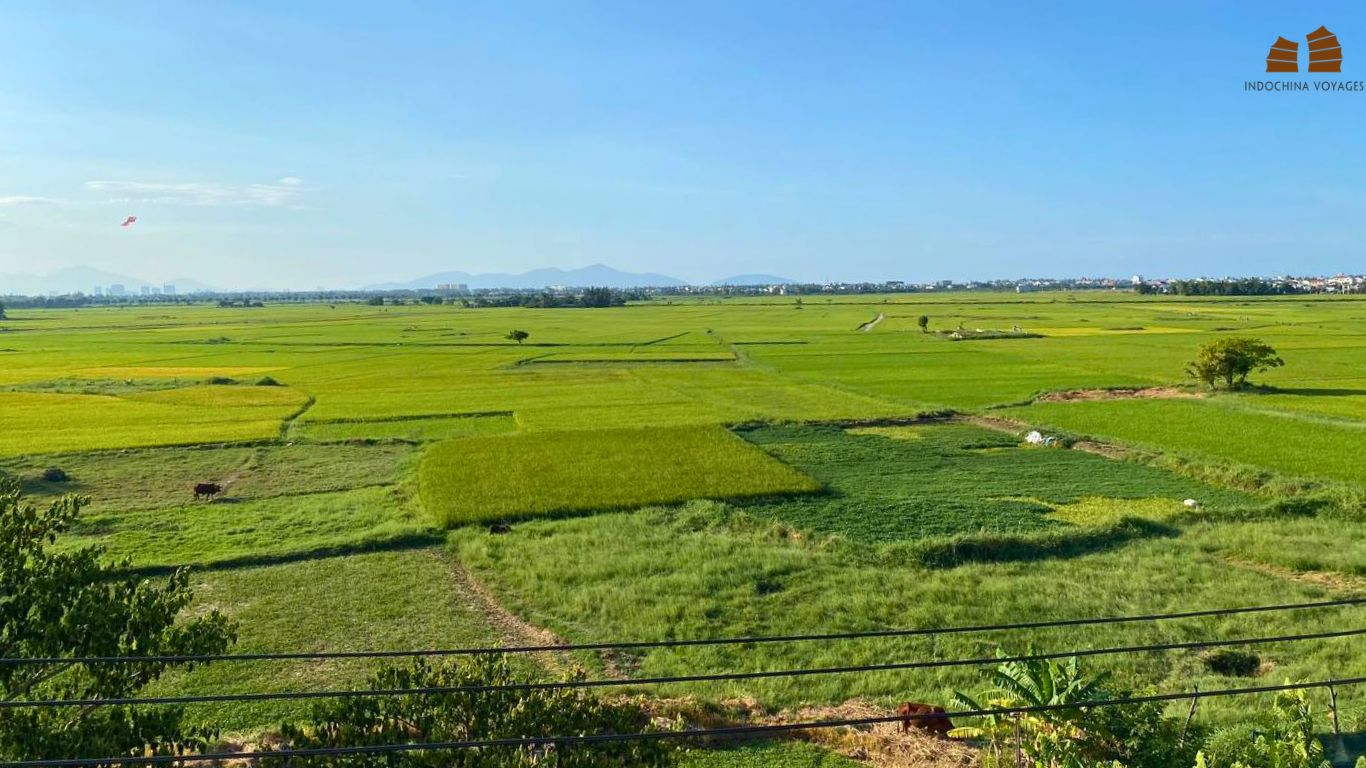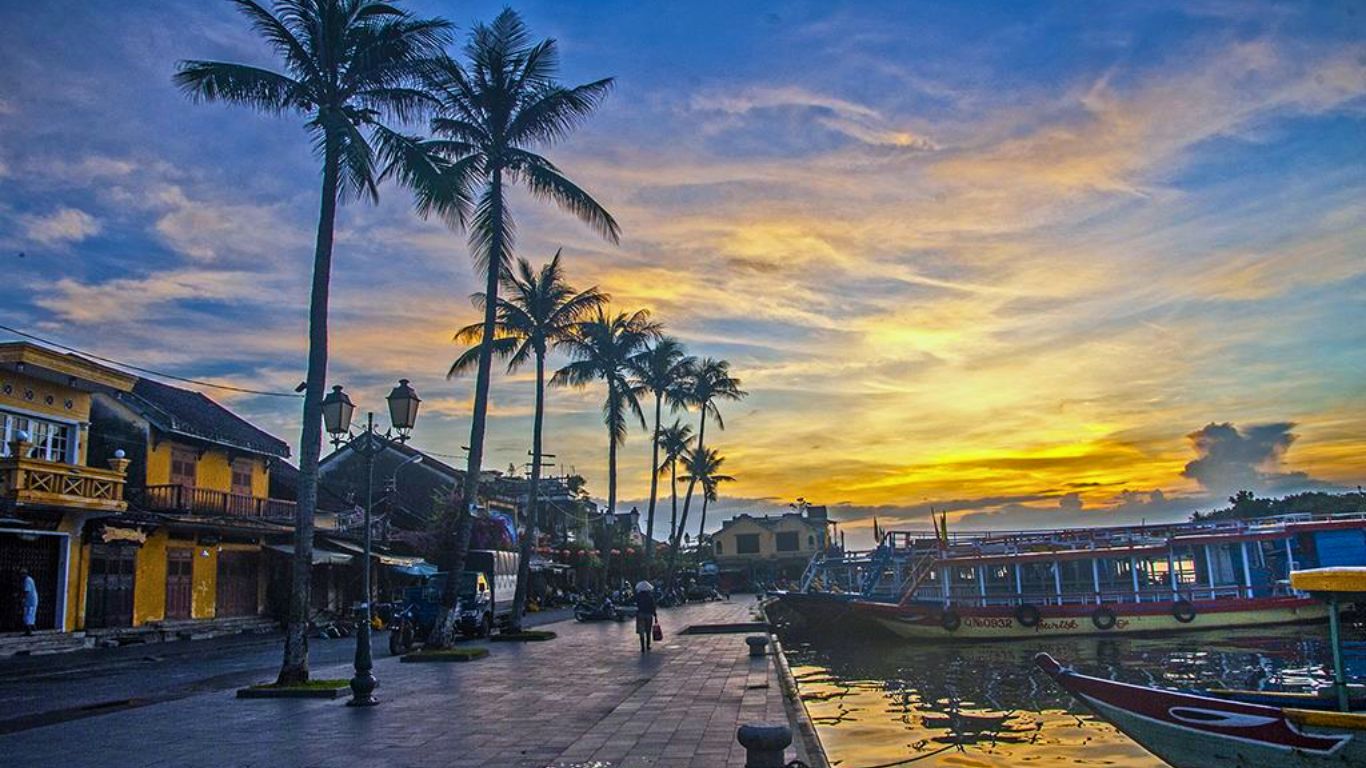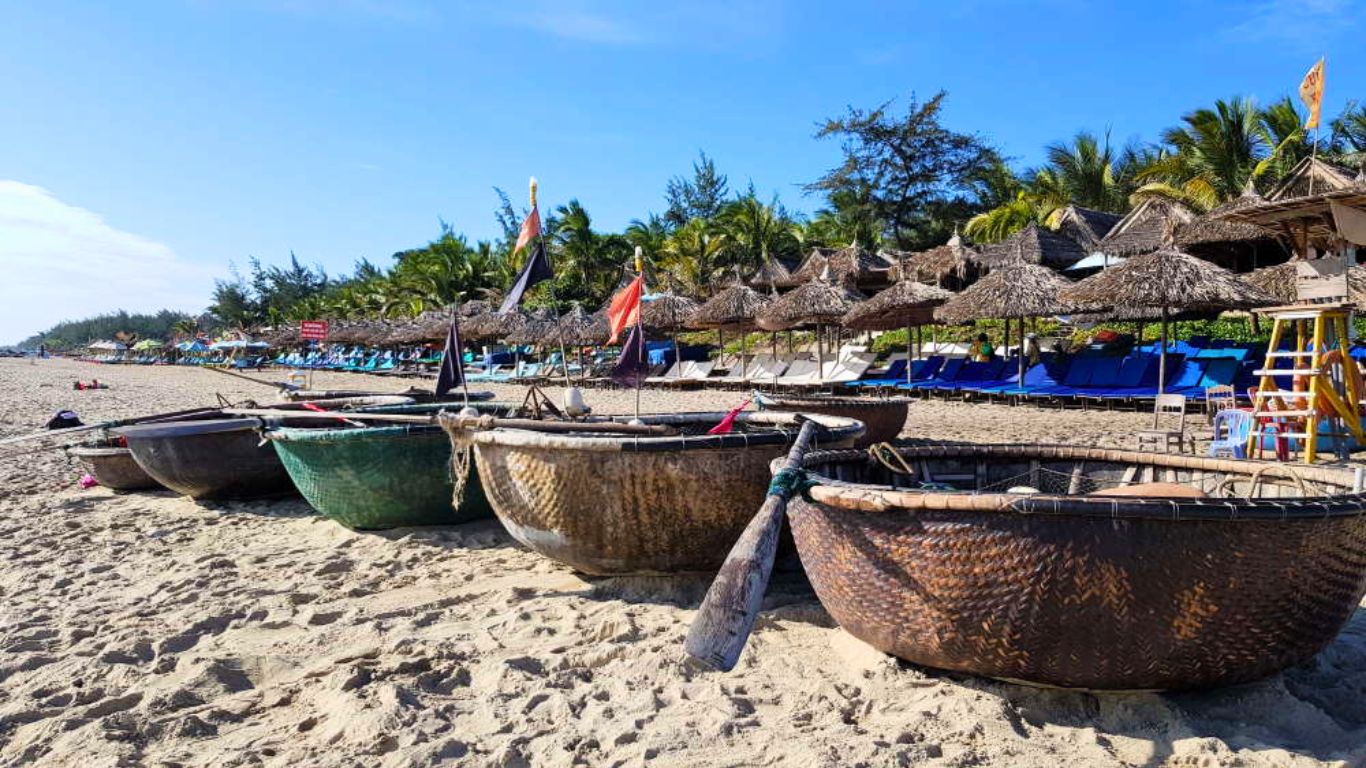Hoi An has two main seasons: dry and rainy. The dry season is warm to hot with low humidity and is best for outdoor activities. The rainy season has increased rainfall with occasional storms, with October and November receiving the highest amounts. To choose the best time to visit Hoi An according to your preferences, take a look at our blog for more information.
When are the best months to visit Hoi An?

Hoi An from January to March
During January, Hoi An is a peaceful and inviting destination, with gentle breezes and mild temperatures. Exploring the ancient streets and serene rice fields is a perfect way to spend your leisurely days.
February, on the other hand, is a livelier period, as the town celebrates the Lunar New Year with vibrant cultural festivities, street parades, and mesmerizing lantern displays. You will be spellbound by the atmosphere created by the beautiful cobblestone pathways.
Come March, the countryside comes alive with lush green and gold hues, and nature blooms into a new season. Hoi An offers pleasant weather during March, which is perfect for outdoor adventures or indulging in delectable culinary delights.

Hoi An in April & May
April and May fall within the dry season in Hoi An, offering pleasant weather conditions. During this time, the temperatures are generally warm but not excessively hot, ranging from 24°C to 30°C (75°F to 86°F). The humidity levels are relatively lower compared to the peak of the hot season, making it more comfortable for outdoor activities and exploration.
These months are also considered shoulder seasons in Hoi An, meaning there are fewer tourists compared to the peak months. This translates to less crowded attractions, shorter lines, and a more relaxed atmosphere. You can enjoy exploring Hoi An’s landmarks, markets, and streets without feeling overwhelmed by large crowds.
Peak Tourist Seasons
High Season: January to March
The peak tourist season in Hoi An, Vietnam typically falls between January to March. During this period, the weather in Hoi An is generally warm and dry, making it an ideal time to explore the city’s attractions and enjoy outdoor activities. Since it is the peak season, you can expect higher prices for accommodations, tours, and other services in Hoi An.
You should also note that popular tourist sites and attractions may have larger crowds during the peak season. It’s recommended to plan your visits early in the day to avoid the busiest times and choose to visit outskirt Hoi An to make the most of your time.

Shoulder Season (April – September)
The shoulder seasons, spanning from April to September, offer a balance between favorable weather conditions and fewer crowds. From July to September, Hoi An enters the transition season when it starts to rain and the climate is chilly at night. The number of tourists in these months also begins to gradually decrease. The number of tourists is not too crowded, which is an ideal condition to visit popular cultural and historical tourist destinations.

Low season (October – December)
The low season, which occurs during the rainy months from October to December, sees increased precipitation and occasional typhoons. While the weather may be less predictable, adventurous travelers can still find unique experiences and discounted rates on accommodations.
Special Events and Festivals
Hoi An Lantern Festival
On the 14th day of each lunar month, Hoi An’s Old Town comes alive with the enchanting Lantern Festival. The streets are adorned with colorful lanterns, and motorized vehicles are prohibited, creating a magical atmosphere. You can release floating lanterns on the river, enjoy traditional music and dance performances, and savor local delicacies.
Hoi An Mid-Autumn Festival
Mid-Autumn Festival is a special festival that not only takes place in Hoi An but is also held bustlingly across Vietnam on the full moon day of the 8th lunar month every year. On this day, all the streets are decorated with bright lanterns, people and tourists together carry lanterns, make feasts, etc. During the Mid-Autumn Festival, you can see lion dance troupes on the streets, lanterns with unique shapes glowing all over the roads and the sight of children playing together will bring unforgettable impressions.

Weather in Hoi An by season
Dry Season in Hoi An (January – July)
The dry season in Hoi An lasts from January to July, and it is the ideal time to visit this beautiful town. During this time, the skies are clear. January offers mild weather, making it perfect for exploring the town’s historic sites and tranquil rivers. February marks the onset of spring, with temperatures gradually rising and the festive spirit of Tet enveloping the streets. In March, the days become warmer, making it an ideal time to immerse oneself in the town’s vibrant culture and bask in the sunshine.
As spring transitions into summer, April and May bring peak temperatures, creating the perfect conditions for lazy days by the beach or leisurely bike rides through the countryside. By June and July, the scorching heat is somewhat relieved, with occasional showers refreshing the air and nourishing the lush greenery that defines Hoi An’s landscape.
Insider tips to travel: It is advisable to postpone your trip to the end of May or the beginning of June if you are fond of sunbathing on the renowned beaches near Hoi An, such as Cua Dai Beach or An Bang Beach. The offshore islands of Cu Lao Cham are typically accessible from late May to the end of August due to calmer seas.

Transition season (August – September)
As summer turns to fall, the months of August and September mark the transition season in Hoi An. During this time, the weather can be unpredictable, with occasional showers and fluctuating temperatures. Despite the increased rainfall, you can continue to flock to Hoi An to witness its natural beauty and cultural richness.
In August, the interplay of sunshine and rain creates a beautiful mosaic of colors that adds to the town’s charm. September brings cooler temperatures and rejuvenating showers, providing relief from the summer heat. It’s the perfect time for outdoor adventures and exploration in the rejuvenated countryside.

Rainy Season (October – December)
The rainy season in Hoi An takes place from October to December and brings a peaceful atmosphere to the city. The light showers provide nourishment to the earth and replenish the rivers and rice fields, making the landscape lush and green. Visiting Hoi An in October is a serene experience, with the scent of wet earth filling the air. November is the peak of the rainy season, with frequent downpours throughout the day and night. However, Hoi An’s charm remains intact, allowing you to experience its beauty and charm. In December, the rainy season comes to an end, and drier days gradually return. The festive season is also a perfect time to visit the city and enjoy its unique atmosphere.

Frequently asked questions
What is the rainiest month in Hoi An?
October and November are the rainiest months in Hoi An, marking the start of the rainy season. During this time, you can expect frequent downpours that may sometimes interrupt outdoor activities. However, don’t let the rain get you down; Hoi An’s charm still shines through, offering unique experiences even in the rain.
When to avoid Hoi An?
While Hoi An boasts allure throughout the year, you may opt to avoid the peak of the rainy season from October to December if you prefer drier weather. Additionally, those sensitive to high temperatures might find April and May less favorable due to the intense heat. Planning your visit from January to March or July to September can offer a balance of pleasant weather and fewer crowds.
Is Hoi An too touristy?
Hoi An is a popular tourist destination, but it has much more to offer than just busy crowds. While some areas, such as the Ancient Town, may experience high foot traffic, there are plenty of opportunities to discover quieter corners and fully immerse yourself in the town’s rich culture and heritage. It’s possible to enjoy the touristy aspects while also seeking out hidden gems to have a well-rounded experience.
Is it better to stay in Da Nang or Hoi An?
Choosing between staying in Da Nang or Hoi An ultimately depends on your preferences and itinerary. Hoi An offers a quaint, historic ambiance with its ancient streets and lantern-lit alleys, ideal for those seeking a relaxed, cultural experience. On the other hand, Da Nang boasts modern amenities, stunning beaches, and convenient access to nearby attractions like the Marble Mountains and Ba Na Hills. Consider your priorities and desired atmosphere when making your decision.
How many days do you need in Hoi An?
The duration of an ideal visit to Hoi An depends on your personal interests and travel goals. While some may find two to three days enough time to explore the main attractions of the town, others may prefer to stay longer to delve deeper into its cultural offerings and immerse themselves in local experiences. Allocating at least a couple of days is recommended to fully appreciate Hoi An’s charm and ambiance without feeling rushed.
Choosing the best time to visit Hoi An depends on your preferences and priorities. However, February to April and July to September offer the most favorable weather. Whether you seek pleasant temperatures, vibrant festivals, or a tranquil ambiance, these periods provide optimal conditions for exploring Hoi An’s charms.






